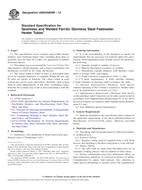Potrebujeme váš súhlas na využitie jednotlivých dát, aby sa vám okrem iného mohli ukazovať informácie týkajúce sa vašich záujmov. Súhlas udelíte kliknutím na tlačidlo „OK“.
ASTM E309-11
Standard Practice for Eddy-Current Examination of Steel Tubular Products Using Magnetic Saturation
Automaticky preložený názov:
Štandardné praktiky pre vírivé vyšetrenie oceľových Tubular Products pomocou magnetického nasýtenia
NORMA vydaná dňa 15.2.2011
Informácie o norme:
Označenie normy: ASTM E309-11
Poznámka: NEPLATNÁ
Dátum vydania normy: 15.2.2011
Kód tovaru: NS-46361
Počet strán: 6
Približná hmotnosť: 18 g (0.04 libier)
Krajina: Americká technická norma
Kategória: Technické normy ASTM
Kategórie - podobné normy:
Železné a ocelové trubky
Ocelové trubky a trouby pro specifické použití
Anotácia textu normy ASTM E309-11 :
Keywords:
discontinuity, encircling coil, ferromagnetic pipe, ferromagnetic tubing, magnetic saturation system, magnetizing field strength, probe coil, tube, tubular product, Steel pipe (nondestructive testing), Steel tube (nondestructive testing), Structural steel (SS) tube, Tubular products, Discontinuities--metals/alloys, Eddy current examination, Electromagnetic (eddy current) testing, Encircling coil method, Ferromagnetic pipe/tube, Magnetic saturation (MS), Nondestructive evaluation (NDE)
Doplňujúce informácie
| Significance and Use | ||||
|
The purpose of this practice is to outline a procedure for the detection and location of discontinuities such as pits, voids, inclusions, cracks, or abrupt dimensional variations in ferromagnetic tubing using the electromagnetic (eddy-current) method. Furthermore, the relative severity of a discontinuity may be indicated, and a rejection level may be set with respect to the magnitude of the indication. The response from natural discontinuities can be significantly different than that from artificial discontinuities such as drilled holes or notches. For this reason, sufficient work should be done to establish the sensitivity level and set-up required to detect natural discontinuities of consequence to the end use of the product. Eddy-current testing systems are generally not sensitive to discontinuities adjacent to the ends of the tube. The extent of the end effect region can be determined in accordance with 8.6. Since the density of eddy currents decreases nearly exponentially as the distance from the external surface increases, the response to deep-seated discontinuities decreases and some deep-seated discontinuities may give no detectable repsonse. Discontinuity orientation also affects the system response and should be taken into consideration when establishing the examination sensitivity. In preparing a reference standard for welded tubing, artificial discontinuities should be placed in both the weld metal and the parent metal when the responses are expected to be different and if both are to be examined. The apparatus is then adjusted to obtain an optimum signal-to-noise ratio. When examining only the weld area, the discontinuities shall be placed only in the weld area. The examination frequency and the type of apparatus being used should be considered when choosing the examining speed. Certain types of equipment are effective only over a given speed range; therefore, the examining speed should fall within this range. Discontinuities such as scratches or seams that are continuous and uniform over the full length of the tube may not always be detected with differential encircling coils or probes scanned along the tube length. |
||||
| 1. Scope | ||||
|
1.1 This practice covers a procedure for applying the eddy-current method to detect discontinuities in ferromagnetic pipe and tubing (Note 1) where the article being examined is rendered substantially non-magnetic by the application of a concentrated, strong magnetic field in the region adjacent to the examining coil. Note 1—For convenience, the term tube or tubular product will hereafter be used to refer to both pipe and tubing. 1.2 The procedure is specifically applicable to eddy-current testing methods using an encircling-coil assembly. However, eddy-current techniques that employ either fixed or rotating probe-coil assemblies may be used to either enhance discontinuity sensitivity on the large diameter tubular products or to maximize the response received from a particular type of discontinuity. 1.3 This practice is intended for use on tubular products having outside diameters from approximately 1/4 to 10 in. (6.35 to 254.0 mm). These techniques have been used for smaller and larger sizes however, and may be specified upon contractual agreement between the purchaser and the supplier. 1.4 This practice does not establish acceptance criteria; they must be specified by the using party or parties. 1.5 The values stated in inch-pound units are to be regarded as standard. The values given in parentheses are mathematical conversions to SI units that are provided for information only and are not considered standard. |
||||
| 2. Referenced Documents | ||||
|
Podobné normy:
Historická
1.5.2013
Historická
1.3.2012
Historická
1.10.2009
Historická
1.3.2008
Historická
1.5.2014
Historická
1.12.2010
Odporúčame:
Aktualizácia technických noriem
Chcete mať istotu, že používate len platné technické normy?
Ponúkame Vám riešenie, ktoré Vám zaistí mesačný prehľad o aktuálnosti noriem, ktoré používate.
Chcete vedieť viac informácií ? Pozrite sa na túto stránku.



 ASTM A798/A798M-13..
ASTM A798/A798M-13.. ASTM A803/A803M-12..
ASTM A803/A803M-12.. ASTM A813/A813M-09..
ASTM A813/A813M-09.. ASTM A814/A814M-08..
ASTM A814/A814M-08.. ASTM A847/A847M-14..
ASTM A847/A847M-14.. ASTM A849-10
ASTM A849-10
 Cookies
Cookies
